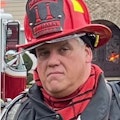Critical, informed decisions that incident commanders (ICs) make almost immediately after arrival and a complete 360-degree size-up define the outcome of an incident. Many clues that are present can help to determine what’s going on inside of a building. However, these clues can go unheeded by officers who don’t understand what they’re seeing.
No matter the size-up process that one employs, some constants should be looked at for decision-making, and “looked at” shall mean through the lens of a thermal imaging camera (TIC).
(For this discussion, the focus is the owner-occupied, single-family dwelling. Almost 90 percent of the fires that we fight nationwide occur in such a structure.)
The compartment
Knowing the properties of the building, or compartment, is critical to determining the behavior of the combustion process that’s within it. Pre-planning and area tours are vital for crew members to familiarize with types of construction methods and materials that are present in the composition of the response area’s landscape.
Modern residential dwellings are constructed with larger footprints, more air track capabilities and materials that vary in combustibility. Older dwellings might be constructed of legacy materials that have a higher capability of dissipating energy through them without gaseous combustion, and some surfaces might deflect energy at a higher degree back to the seat of the fire.
The thermal properties of each building have an effect on the overall heat release rate (HRR) from the compartment.
The fuel load
Modern furnishings have a much higher HRR than legacy furnishings and can require high-velocity air flow to continue to produce gaseous combustion. How these fuels react within the compartment depends on a few variables:
- The energy of the ignition source
- The composition of the fuel
- The surface-to-mass ratio of the fuel
- The geometry of the fuel
- The density of the fuel, which defines its thermal conductivity
- The orientation of the fuel surface in relation to the energy source
Although you might not have much control over these characteristics, you still must consider them while forming your incident action plan (IAP).
Visual clues on arrival
The first-arriving IC’s complete size-up gauges the potential location of the seat of the fire and of people who might be survivable within the structure. There is a definite relation for survivability for victims based on their proximity to the seat of the fire, including elevation (floor level).
The 360-degree size-up should identify combustion clues for the IAP:
Smoke movement. How are the smoke and products of combustion exiting the compartment? Is the smoke boiling and agitated, with a high level of turbulence? Is the smoke more laminar in nature, which suggests that the fire might be deep-seated (from the exit point of the smoke or in an earlier stage of gaseous combustion)?
Ignitability. A critical question for the IC: Why isn’t the smoke burning? The question has two possible answers: The smoke either is too cool (needs a heat source) or is too rich (needs more air entrainment). Viewing the exiting smoke with a TIC can help to answer this question.
Temperature. The exiting fuel of combustion can be hot enough that when it mixes with air a fuel-gas-ignition event can result. This would help to define the potential HRR/energy within the compartment.
Color. The color of the exiting smoke/fuel as a measurement of the fuel-to-air ratio. The darker that the fuel is, the more volatile that the ignition will be, including inside of the compartment.
Height of neutral plane. If the exit point is bidirectional, then the compartment opening serves as both an intake and an exhaust. If the exit opening is unidirectional, the fire gets air from a different opening in the compartment.
Heed the signs
The infrequency of actual structure fires can become a dangerous matter for firefighters of all sorts: Critical experience in actual fire behavior can be limited, at best. The first-due officer must consider the clues to which the initial arriving companies can avail themselves. Answers might be right in front of you for developing the correct IAP.
Mike Daley will present “First Due? Then It Is Up to You!!!” at Firehouse Expo. To register, visit firehouseexpo.com.
About the Author

Michael Daley
MICHAEL DALEY, who is a Firehouse contributing editor, recently retired as a 37-year veteran who served as a captain and department training officer in Monroe Township, NJ. He is a staff instructor at multiple New Jersey fire academies and is an adjunct professor in the Fire Science Program at Middlesex County College. Daley is a nationally known instructor who has presented at multiple conferences, including Firehouse Expo and Firehouse World. His education includes accreditations as a Chief Training Officer and a Fire Investigator, and he completed the Craftsman Level of education with Project Kill the Flashover. Daley is a member of the Institution of Fire Engineers and a FEMA Instructor and Rescue Officer with NJ Urban Search and Rescue Task Force 1. He operates Fire Service Performance Concepts, which is a training and research firm that delivers and develops training courses in many fire service competencies.
